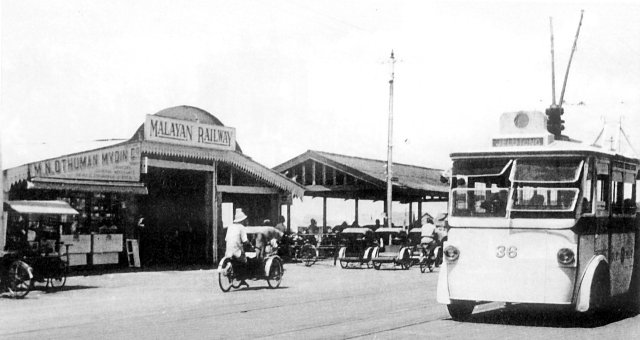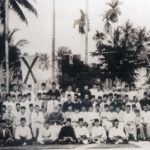Tracing The History Of Sri Kunj Bihari Temple, Penang Road.
The Sri Kunj Bihari temple is the oldest North Indian Temple dedicated to Sri Kunj Bihari (Krishna). It is believed to have been built in the year 1835.The area around this temple is believed to have been the enclave of the North Indian Community comprising of Punjabis, Gujaratis, Sindhis Bengalis and Uttar Pradeshi Bhaiyas and others who settled around there in the early years. Among the early North Indian settlers seem to be names like Samboo Thakur, Basant Banyah and Kelly Shampatty (? Kali Shampatty).

The Sri Kunj Bihari Temple is sited on Lot 17 TS.14 since 1835. Historical records trace this piece of land as follows:
Hence Kelly Shampatty created the above trust for the use of a Hindu Temple forever. The temple is known as Shri Kunj Bihari, which is another name of Sri Krishna. It is one of the two main Vaishnavite temples in Penang and the main temple in which the North Indian have been involved since the early days. The temple also has other properties in Sri Bahari Road and Brunei Road.Kisoree Sokool was obviously the first priest of this temple and as entrusted by Kelly Shampatty succesors of this priest continued to manage the temple until 1906 when the Mohamedan and Hindu Endowments Board took over. From oral history a lineage of priests from various north Indian ethnic backgrounds who served the temple from the early 1900’s have been traced. Amongst them, one of the earliest known priests of the temple was Pandit. Sri Charan Bhatacharjee. He was born in 1866 and came to Penang around 1904. It is learnt that around 1910 he was serving as a priest. His son, the Late Mr. J. Bhattacharjee was born in Penang while he was still a priest there. Mr J Bhattacharjee later on became the Secretary in the temple Management Committee in the late sixties. Pandit Ram Anugerah Sharma was the priest around the year 1935. Pandit Maya Ram was a later successor as a priest from 1937 till 1967 and he was very much around in 1943 when he conducted the marriage ceremony of Mr. and Mrs. Rama Krishna Sharma He is well remembered for his services by various community members. In particular the ladies remember him for his music and bhajans. Amongst the later priests were Pt. Reva Shankar Baradwala 1969-1974, Pt. Dave Vasant Kumar was around from 1979-1985. Mr. Rama Krishna Sharma was a secretary of the temple Management committee around 1953. Extracts from the diary of his father, Rai Sahib Berkat Rai Sharma MCH, a prominent Punjabi gentleman born in 18?? reveal that his father was appointed a committee member by the Hindu Endowment Board as far back as November 27 1922. The late Mr. Hassaram was a committee member around 1945. Hindus of various ethnic backgrounds have actively participated in the temple activities. Quite a number of elderly members of the community remember various events at this temple and remember visiting the temple during their younger days. The Ekadasi Night festival has apparently been conducted since the 1940’s mainly by the South Indian Community. In the later years the celebration of this festival has been managed by the Hindu Mahajana Sangam.
|
||||||||||||||||
| The Ramar Temple, YorkClose. |
||||||||||||||||
| The Sri Ramar Temple is sited on a piece of land, which used to belong to Ranee Dhobi. She is said to have been leader of the washer men who settled around the York Close areaShe was apparently granted a large piece of land on May 2nd, 1802 by order of the governor of Prince of Wales Island, Sir George Leith Baronet, by virtue of authority from the Governor General in Council of Fort Williams in Bengal. Before her death she had created a trust for a temple known as “ Ranee Dhobi’s Koil”. The land under the trust was registered as Lots 171 and 172 T.S. 3. This was confirmed by a will dated July 12 1872 and also by a later trust deed created in 1920.
In 1920 the governor of the straits settlements ordered the trust to be brought under the Mohamedan and Hindu Endowment Boards and this was later handed over to the Hindu Endowment Board in 1967. Presently the The Ranee dhobi site is comprised of an area more than 64,000 sq ft and The Sri Ramar Temple property has almost 18 thousand sq feet. The original structure of Ranee Dhoby koil was a shrine, which existed prior to 1872. In 1982 the temple management committee renovated the shrine, which was in a dilapidated state. Deities of Rama Sita, Hanuman and Ganesh were installed. A larger temple structure was put up around the original shrine. A memorial of Ranee still stands in the walls of the present temple. Craftsman from India built the dome and the façade. Statues representing the ten incarnations of Vishnu were carved on the outer walls of the sanctum sanctorum. The octagonal shape of this inner sanctum is said to follow the original structure. The temple is one of the two main Vaishnavite temples in Penang (the other being Sri Kunj Bihari Temple in Penang Road). As such Vaishnavite priests have to be recruited from India to serve the temple. |
||||||||||||||||
|
On 1st May 1906, this temple and other were committed to the Board. From then onward this temple has been administered by a management committee appointed by the Endowments Board (The Mohammedan and Hindu Endowments Board since 1967). It was only 1933 that the Mahamariamman temple acquired the present form and structure. In that year the temple was extensively renovated and consecration ceremony was held on 12th June 1933. According to the notice of the consecration ceremony, Mr V.Natesam Pillay, J.P, laid the foundation stone for the new structure. The notice goes on to say that “The Maha Muthumariamman temple having become too small and too decayed, the Hindu gentlemen of Penang, with their initiative and perseverance, have bought up two buildings to the north of the temple, expanded the present space and have formed a temple in accordance with the Saiva agamas,with a sanctum, Artha Mandapam (antechamber), mahamandapam(hall), pragaram(circumambient), vimanan (dome), surrounding walls and Raja gopuram (entrance tower). These renovations were carried out by a management committee consisting of S.Ekamparam Pillay, C. Subbaraya Pillay. S.P Natesam Pillay, P.Kalimuthu Vandayar, K.V Karuppiah Thandal and M.R Raju. It is also known that further repairs were done in 1958 and a consecration ceremony, albeit on a small scale, was carried out under the leadership of Mr. Duraisamy Thevar. The Hindu Mahajana Sangam, which was formed in 1935, has had close association with this temple and other temples under the care of the same management. Many members have served in both institutions. They have been associated with the temples formation, renovation and maintenance. The Present Renovation. The present renovation, the most extensive since 1933, began in 1978.A sculptor from the academy of Sculptors in Mahapalipuram, Madras and two assistant sculptors were brought from India to restore the sculptures and temple structure. These sculptors also renovated the Waterfall Ganesha Temple, and this delayed work in Mahamariamman Temple for a while. However after the Waterfall Ganesha Temple renovation was completed and consecration held on 29th April 1979, work on this temple swung into tempo. Although the basic form of the 1933 structure has been retained many new areas have been added. A new hall 31’ x 27’, suitable for small religious functions has been added. Over this, another story has been added for administrative offices. While most of the sculptures have been preserved, some new one has also been added. The statues of the nine forms of Sakti now surround the outerwalls of the sanctum. Sivan with sakti, in the dance pose, adorns one of the main walls. The inner walls of the sanctum, antechamber and the flooring of the whole temple have been changed. The entire temple has been repainted. The smaller shrines of Sivan, Ambigal, Chandikoswarar and Bairavar have domes of their own which have been gold-plated. Within the sanctum, a new statue of Mahamariamman, towering over the main deity, has been formed.At the feet of the main deity, a Sri Chakram has also been erected. The dome of the temple is on base 121/2 ’ square and has a height of 271/4’ This is in three sections and contains 20 statues of gods and goddesses and 12 lions. Its kalasam is 31/2 feet in height and is gold-plated. The entrance tower is 23 high. It contains 38 statues of gods and goddesses 4 swans. It is topped with five small kalasams. The back entrance tower is 10 high and contains 13 statues of gods and goddesses, 4 lions and swan with partially human form. The Mahamariamman Temple, Lorong Tepi Laut, Butterworth The Bala Thandayuthapani and Ganeshar Temple, Waterfall Road The temple underwent a major renovation in 1984-1985. In recent years, it has attracted a large number of devotees. There is also a separate shrine for Ganesa at the floor of the staircase leading to the Bala Thandayuthapani Temple. This shrine has developed into a separate temple with its own group of devotees. Recently, a complete rebuilding was done.
|
||||||||||||||||


